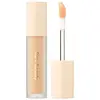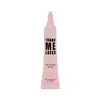What's inside
What's inside
 Key Ingredients
Key Ingredients

 Benefits
Benefits

 Concerns
Concerns

 Ingredients Side-by-side
Ingredients Side-by-side

Water
Skin ConditioningIsododecane
EmollientTalc
AbrasiveDimethicone
EmollientCetyl PEG/PPG-10/1 Dimethicone
EmulsifyingPolysilicone-11
Trimethylsiloxysilicate
EmollientGlycerin
HumectantPhenoxyethanol
PreservativeSodium Chloride
MaskingMagnesium Sulfate
Hydrogen Dimethicone
Sodium Dehydroacetate
PreservativeDisteardimonium Hectorite
StabilisingAluminum Hydroxide
EmollientBenzoic Acid
MaskingDehydroacetic Acid
PreservativeLaureth-12
EmulsifyingPropylene Carbonate
SolventEthylhexylglycerin
Skin ConditioningCI 77891
Cosmetic ColorantIron Oxides
Water, Isododecane, Talc, Dimethicone, Cetyl PEG/PPG-10/1 Dimethicone, Polysilicone-11, Trimethylsiloxysilicate, Glycerin, Phenoxyethanol, Sodium Chloride, Magnesium Sulfate, Hydrogen Dimethicone, Sodium Dehydroacetate, Disteardimonium Hectorite, Aluminum Hydroxide, Benzoic Acid, Dehydroacetic Acid, Laureth-12, Propylene Carbonate, Ethylhexylglycerin, CI 77891, Iron Oxides
Cyclopentasiloxane
EmollientTalc
AbrasiveIsododecane
EmollientCyclohexasiloxane
EmollientDisteardimonium Hectorite
StabilisingVp/Hexadecene Copolymer
Polyisobutene
Trihydroxystearin
Skin ConditioningCI 77163
Cosmetic ColorantSilica Dimethyl Silylate
EmollientTrimethylsiloxysilicate
EmollientPropylene Carbonate
SolventSorbitan Sesquioleate
EmulsifyingBeeswax
Emulsion StabilisingPEG-40 Stearate
EmulsifyingCaprylyl Glycol
EmollientDimethicone
EmollientEthylhexylglycerin
Skin Conditioning1,2-Hexanediol
Skin ConditioningMethicone
EmollientTocopheryl Acetate
AntioxidantMica
Cosmetic ColorantCI 77891
Cosmetic ColorantCI 77491
Cosmetic ColorantCyclopentasiloxane, Talc, Isododecane, Cyclohexasiloxane, Disteardimonium Hectorite, Vp/Hexadecene Copolymer, Polyisobutene, Trihydroxystearin, CI 77163, Silica Dimethyl Silylate, Trimethylsiloxysilicate, Propylene Carbonate, Sorbitan Sesquioleate, Beeswax, PEG-40 Stearate, Caprylyl Glycol, Dimethicone, Ethylhexylglycerin, 1,2-Hexanediol, Methicone, Tocopheryl Acetate, Mica, CI 77891, CI 77491
Ingredients Explained
These ingredients are found in both products.
Ingredients higher up in an ingredient list are typically present in a larger amount.
Ci 77891 is a white pigment from Titanium dioxide. It is naturally found in minerals such as rutile and ilmenite.
It's main function is to add a white color to cosmetics. It can also be mixed with other colors to create different shades.
Ci 77891 is commonly found in sunscreens due to its ability to block UV rays.
Learn more about CI 77891Dimethicone is a type of synthetic silicone created from natural materials such as quartz.
What it does:
Dimethicone comes in different viscosities:
Depending on the viscosity, dimethicone has different properties.
Ingredients lists don't always show which type is used, so we recommend reaching out to the brand if you have questions about the viscosity.
This ingredient is unlikely to cause irritation because it does not get absorbed into skin. However, people with silicone allergies should be careful about using this ingredient.
Note: Dimethicone may contribute to pilling. This is because it is not oil or water soluble, so pilling may occur when layered with products. When mixed with heavy oils in a formula, the outcome is also quite greasy.
Learn more about DimethiconeDisteardimonium Hectorite comes from the clay mineral named hectorite. It is used to add thickness to a product.
It can also help stabilize a product by helping to disperse other ingredients.
Hectorite is a rare, white clay mineral.
Learn more about Disteardimonium HectoriteEthylhexylglycerin (we can't pronounce this either) is commonly used as a preservative and skin softener. It is derived from glyceryl.
You might see Ethylhexylglycerin often paired with other preservatives such as phenoxyethanol. Ethylhexylglycerin has been found to increase the effectiveness of these other preservatives.
Isododecane is a fragrance, emollient, and solvent.
As an emollient, it helps your skin stay soft and hydrated. Emollients help trap moisture into your skin.
Isododecane's role as a solvent makes it a great texture enhancer. It spreads smoothly on skin and does not leave a sticky feeling behind. Isododecane also helps prevent color transfer in makeup products.
Isododecane is not absorbed into skin.
Learn more about IsododecaneThis ingredient is a solvent. It helps dissolve active ingredients and alter the texture of products.
Propylene Carbonate is commonly used in makeup and with clay, such as montmorillonite or bentonite.
Studies show this ingredient to be safe for cosmetics. When it is undiluted, it can cause skin irritation. (It is always diluted in skincare and makeup). This ingredient is water-soluble.
Propylene Carbonate is created from propylene glycol and carbonic acid.
Learn more about Propylene CarbonateTalc is a clay mineral. It helps absorb moisture and improve the texture of products. Like other types of clay, Talc can have a slight exfoliating effect on skin. Talc can be added to increase the volume of products.
Some Baby powders are made by combining talc with corn starch. The word "talc" comes from Latin and originates from Arabic. Talc is a mineral commonly found throughout the world.
If you have any concerns about using talc, we recommend checking out the FDA's official page.
Learn more about TalcThis silicone is an emollient. Emollients create a thin film on the skin to prevent moisture from escaping.
It is not soluble in water and helps increase water-resistance in products.
According to a manufacturer, it can blend seamlessly with silicone oils, such as Cyclopentasiloxane.
Learn more about Trimethylsiloxysilicate